Simulating Soil Carbon Under Variable Nitrogen Application, Planting, and Residue Management
Abstract
1. Introduction
2. Materials and Methods
2.1. Model Description
2.2. Experimental Years and Data
2.3. Non-Experimental Years and Data
2.4. Soil Data
2.5. Climate Data
2.6. Simulation Study
2.6.1. RUSLE and RUSLE Files
2.6.2. CQESTR Model Operation
2.7. Model Application and Performance Evaluation
3. Results and Discussion
3.1. Crop Residue and Root Biomass
3.2. CQESTR Model Performance
3.3. Effect of Nitrogen Application, Planting Date, and Residue Return
3.4. Soil Organic Carbon Dynamics
4. Findings and Recommendations
Supplementary Materials
Author Contributions
Funding
Data Availability Statement
Acknowledgments
Conflicts of Interest
References
- FAO. FAOSTAT (Online). 2020. Available online: https://www.fao.org/faostat/en/#home (accessed on 18 August 2021).
- Hussain, T.; Anothai, J.; Nualsri, C.; Soonsuwon, W. Evaluating Performance of Sixteen Upland Rice Genotypes under Field Conditions for Further Breeding Process. J. Agric. Sci 2018, 10, 144–150. [Google Scholar] [CrossRef][Green Version]
- Norsuwan, T.; Utasuk, K.; Panyasai, T.; Sangchyoswat, C. Optimization of Nitrogen Fertilizer Application in Lowland Rice Production System of Agricultural Resource System Research Station Using Tailored Farm-Plot Database. Chiang Mai Univ. J. Nat. Sci. 2020, 19, 333–349. [Google Scholar] [CrossRef]
- Hussain, T.; Gollany, H.T.; Mulla, D.J.; Ben, Z.; Tahir, M.; Ata-ul-karim, S.T.; Liu, K.; Maqbool, S.; Hussain, N.; Duangpan, S. Assessment and Application of EPIC in Simulating Upland Rice Productivity, Soil Water, and Nitrogen Dynamics under Different Nitrogen Applications and Planting Windows. Plants 2023, 13, 2379. [Google Scholar] [CrossRef]
- DRRD Soil and Fertilizer Management in Rice Fields, Fertilizer Recommendations for Southern Region. Rice Knowledge Bank. 2017. Available online: https://webold.ricethailand.go.th/rkb3/title-index.php-file=content.php&id=043.htm#p9 (accessed on 22 December 2021).
- Candradijaya, A.; Kusmana, C.; Syaukat, Y.; Syaufina, L.; Faqih, A. Climate Change Impact on Rice Yield and Adaptation Response of Local Farmers in Sumedang District, West Java, Indonesia. Int. J. Ecosyst. 2014, 4, 212–223. [Google Scholar] [CrossRef]
- Thai Rice Exporters Association Rice Production Forecast Results 2017–2022. 2022.
- Kanchanapiya, P.; Tantisattayakul, T. Enhancing Carbon Reduction and Sustainable Agriculture in Thailand: An Assessment of Rice Straw Utilization Strategies. Green Technol. Sustain. 2025, 3, 100136. [Google Scholar] [CrossRef]
- ONEP Second Biennial Update Report of Thailand; UNFCCC: Bangkok, Thailand, 2017.
- Cheewaphongphan, P.; Junpen, A.; Garivait, S.; Kamnoet, O. Study on the Potential of Rice Straws as a Supplementary Fuel in Very Small Power Plants. Energies 2018, 11, 270. [Google Scholar] [CrossRef]
- Cha-un, N.; Chidthaisong, A.; Yagi, K.; Sudo, S.; Towprayoon, S. Greenhouse Gas Emissions, Soil Carbon Sequestration and Crop Yields in a Rain-Fed Rice Field with Crop Rotation Management. Agric. Ecosyst. Environ. 2017, 237, 109–120. [Google Scholar] [CrossRef]
- Ali, A.; Hussain, T.; Zahid, A. Smart Irrigation Technologies and Prospects for Enhancing Water Use Efficiency for Sustainable Agriculture. AgriEngineering 2025, 7, 106. [Google Scholar] [CrossRef]
- Ali, A.; Hussain, T.; Tantashutikun, N.; Hussain, N.; Cocetta, G. Application of Smart Techniques, Internet of Things and Data Mining for Resource Use Efficient and Sustainable Crop Production. Agriculture 2023, 13, 397. [Google Scholar] [CrossRef]
- Jones, J.W.; Hoogenboom, G.; Porter, C.H.; Boote, K.J.; Batchelor, W.D.; Hunt, L.A.; Wilkens, P.W.; Singh, U.; Gijsman, A.J.; Ritchie, J.T. The DSSAT Cropping System Model. Eur. J. Agron. 2003, 18, 235–265. [Google Scholar] [CrossRef]
- Chang, K.-H.; Warland, J.; Voroney, P.; Bartlett, P.; Wagner-Riddle, C. Using DayCENT to Simulate Carbon Dynamics in Conventional and No-Till Agriculture. Soil Sci. Soc. Am. J. 2013, 77, 941–950. [Google Scholar] [CrossRef]
- Gollany, H.T.; Elnaggar, A.A. Simulating Soil Organic Carbon Changes across Toposequences under Dryland Agriculture Using CQESTR. Ecol. Modell. 2017, 355, 97–104. [Google Scholar] [CrossRef]
- Cavigelli, M.A.; Nash, P.R.; Gollany, H.T.; Rasmann, C.; Polumsky, R.W.; Le, A.N.; Conklin, A.E. Simulated Soil Organic Carbon Changes in Maryland Are Affected by Tillage, Climate Change, and Crop Yield. J. Environ. Qual. 2018, 47, 588–595. [Google Scholar] [CrossRef]
- Wienhold, B.J.; Schmer, M.R.; Jin, V.L.; Varvel, G.E.; Gollany, H. CQESTR Simulated Changes in Soil Organic Carbon under Residue Management Practices in Continuous Corn Systems. BioEnergy Res. 2016, 9, 23–30. [Google Scholar] [CrossRef]
- Gollany, H.T.; Fortuna, A.M.; Samuel, M.K.; Young, F.L.; Pan, W.L.; Pecharko, M. Soil Organic Carbon Accretion vs. Sequestration Using Physicochemical Fractionation and CQESTR Simulation. Soil Sci. Soc. Am. J. 2013, 77, 618–629. [Google Scholar] [CrossRef]
- Liang, Y.; Gollany, H.T.; Rickman, R.W.; Albrecht, S.L.; Follett, R.F.; Wilhelm, W.W.; Novak, J.M.; Douglas, C.L. Simulating Soil Organic Matter with CQESTR (v. 2.0): Model Description and Validation against Long-Term Experiments across North America. Ecol. Modell. 2009, 220, 568–581. [Google Scholar] [CrossRef]
- Rickman, R.W.; Douglas, C.L., Jr.; Albrecht, S.L.; Bundy, L.G.; Berc, J.L. CQESTR: A Model to Estimate Carbon Sequestration in Agricultural Soils. J. Soil Water Conserv. 2001, 56, 237–242. [Google Scholar] [CrossRef]
- Nash, P.R.; Gollany, H.T.; Sainju, U.M. CQESTR-Simulated Response of Soil Organic Carbon to Management, Yield, and Climate Change in the Northern Great Plains Region. J. Environ. Qual. 2018, 47, 674–683. [Google Scholar] [CrossRef]
- Renard, K.G.; Foster, G.R.; Weesies, G.A.; McCool, D.K.; Yoder, D.C. Predicting Soil Erosion by Water: A Guide to Conservation Planning with the Revised Universal Soil Loss Equation (RUSLE); USDA: Washington, DC, USA, 1996. [Google Scholar]
- Gollany, H.T.; Follett, R.F.; Liang, Y. Chapter 16—CQESTR Simulations of Soil Organic Carbon Dynamics; Liebig, M.A., Franzluebbers, A.J., Follett, R.F.B.T.-M.A.G.G., Eds.; Academic Press: San Diego, CA, USA, 2012; pp. 271–292. ISBN 978-0-12-386897-8. [Google Scholar]
- Thai Meteorological Department Report; TMD Climatological Center: Bangkok, Thailand, 2021.
- Walkley, A.; Black, I.A. An examination of Degtjareff method for determining soil organic matter, and proposed modification of the chromic acid titration method. Soil Sci. 1934, 37, 29–38. [Google Scholar] [CrossRef]
- Gauch, H.G.; Hwang, J.T.G.; Fick, G.W. Model Evaluation by Comparison of Model-Based Predictions and Measured Values. Agron. J. 2003, 95, 1442–1446. [Google Scholar] [CrossRef]
- Hussain, T.; Hussain, N.; Ahmed, M.; Tahir, M.; Duangpan, S. Synchronizing Nitrogen Fertilization and Planting Date to Improve Resource Use Efficiency, Productivity, and Profitability of Upland Rice. Front. Plant Sci. 2022, 13, 5811. [Google Scholar] [CrossRef]
- Zhang, J.; Tong, T.; Potcho, P.M.; Huang, S.; Ma, L.; Tang, X. Nitrogen Effects on Yield, Quality and Physiological Characteristics of Giant Rice. Agronomy 2020, 10, 1816. [Google Scholar] [CrossRef]
- Jahan, A.; Islam, A.; Sarkar, M.I.U.; Iqbal, M.; Ahmed, M.N.; Islam, M.R. Nitrogen Response of Two High Yielding Rice Varieties as Influenced by Nitrogen Levels and Growing Seasons. Geol. Ecol. Landsc. 2022, 6, 24–31. [Google Scholar] [CrossRef]
- Arunrat, N.; Pumijumnong, N.; Hatano, R. Practices Sustaining Soil Organic Matter and Rice Yield in a Tropical Monsoon Region. Soil Sci. Plant Nutr. 2017, 63, 274–287. [Google Scholar] [CrossRef]
- Wang, S.; Sun, N.; Liang, S.; Zhang, S.; Meersmans, J.; Colinet, G.; Xu, M.; Wu, L. SOC sequestration affected by fertilization in rice-based cropping systems over the last four decades. Front. Environ. Sci. 2023, 11, 1152439. [Google Scholar] [CrossRef]
- Wang, X.; He, C.; Liu, B.; Zhao, X.; Liu, Y.; Wang, Q.; Zhang, H. Effects of Residue Returning on Soil Organic Carbon Storage and Sequestration Rate in China’s Croplands: A Meta-Analysis. Agronomy 2020, 10, 691. [Google Scholar] [CrossRef]
- Keller, A.B.; Handler, S.D. USDA Northern Forests Climate Hub. Soil Organic Carbon in Temperate Managed Ecosystems: A Primer; Northern Institute of Applied Climate Science: Duluth, MN, USA, 2024. [Google Scholar]
- Katoh, T. Carbon Accumulation in Soils by Soil Management, Mainly by Organic Matter Application-Experimental Results in Aichi Prefecture. Jpn. Soc. Soil Sci. Plant Nutr. 2003, 74, 99–104. [Google Scholar] [CrossRef]
- Kladivko, E.J. Tillage Systems and Soil Ecology. Soil Tillage Res. 2001, 61, 61–76. [Google Scholar] [CrossRef]
- Spohn, M.; Bagchi, S.; Biederman, L.A.; Borer, E.T.; Bråthen, K.A.; Bugalho, M.N.; Caldeira, M.C.; Catford, J.A.; Collins, S.L.; Eisenhauer, N.; et al. The Positive Effect of Plant Diversity on Soil Carbon Depends on Climate. Nat. Commun. 2023, 14, 6624. [Google Scholar] [CrossRef] [PubMed]
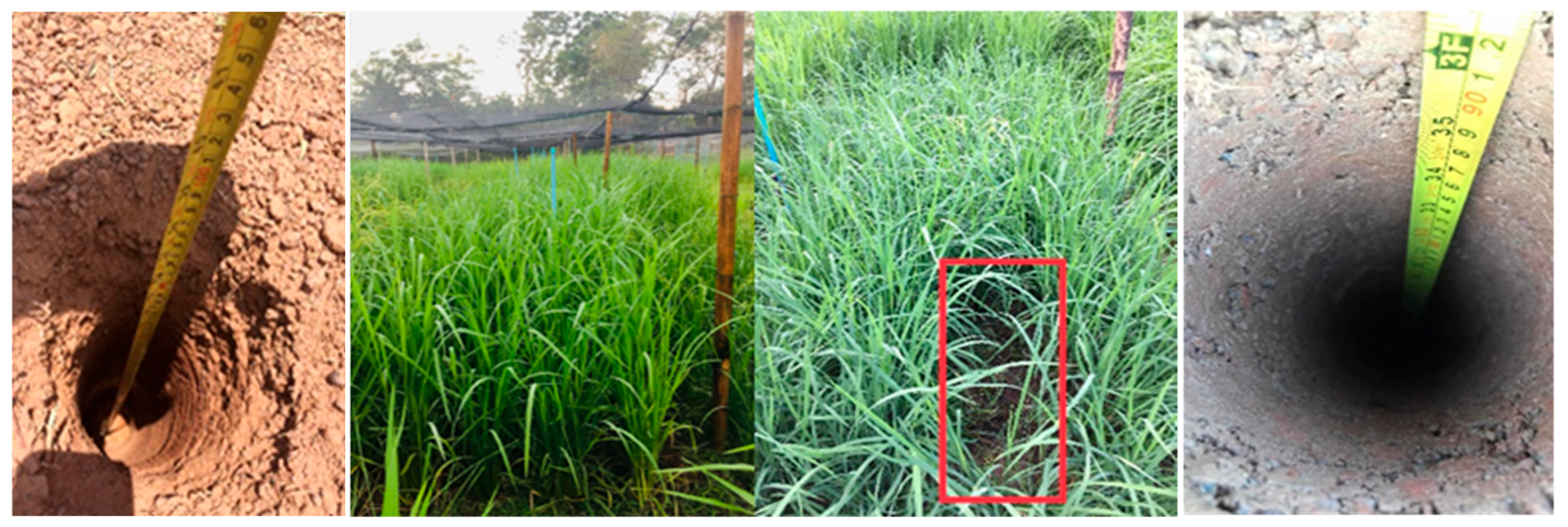
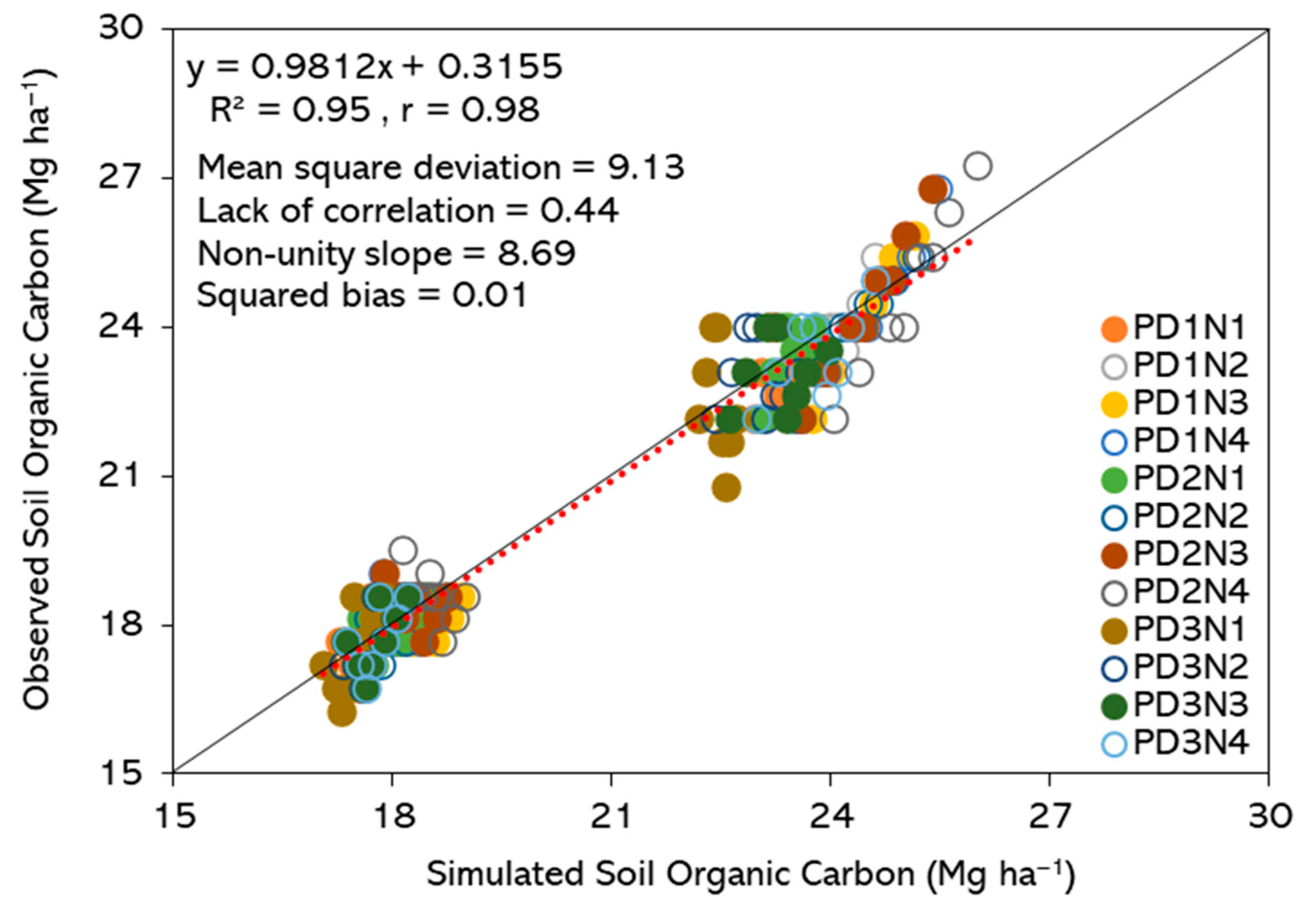

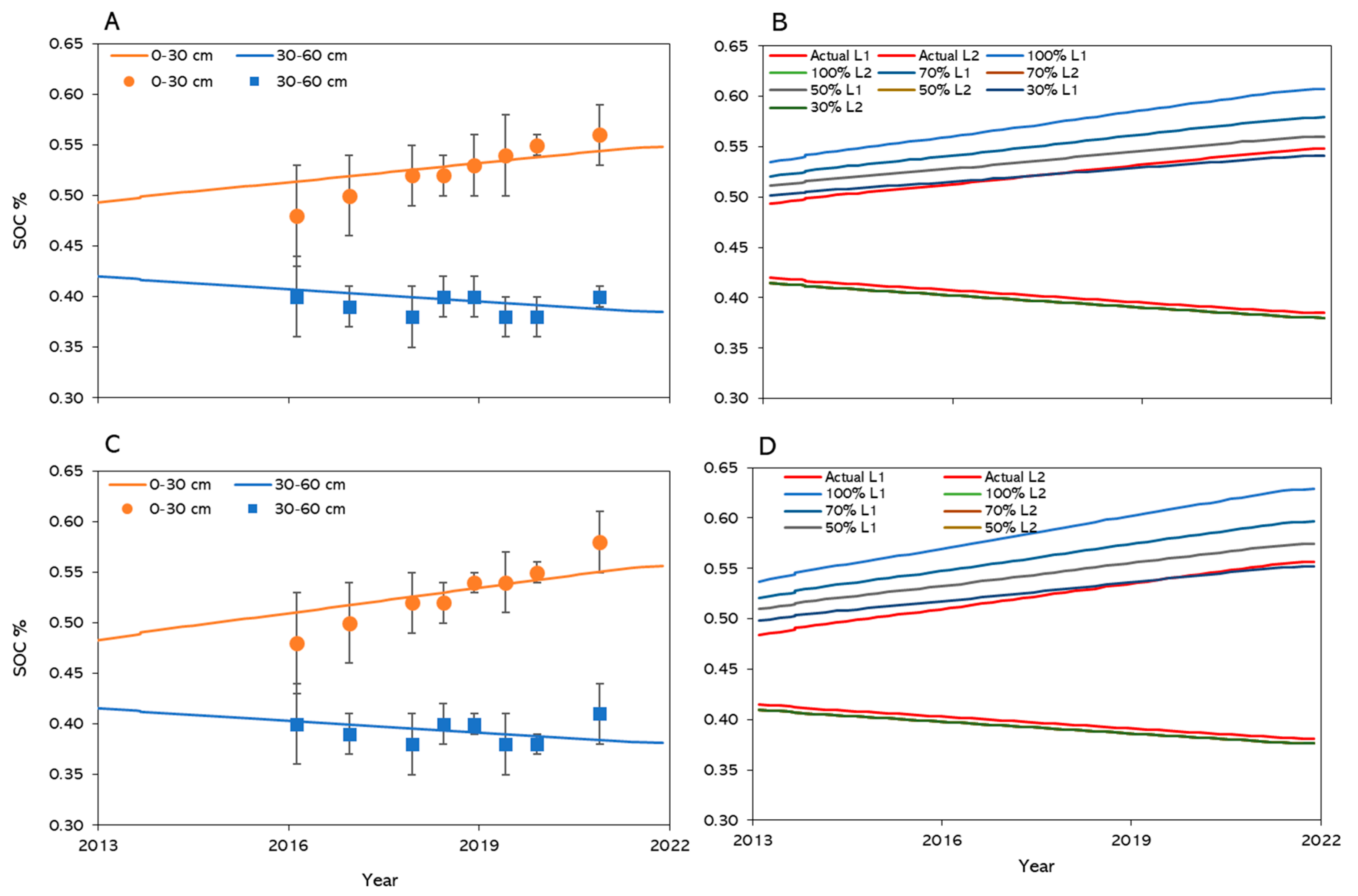
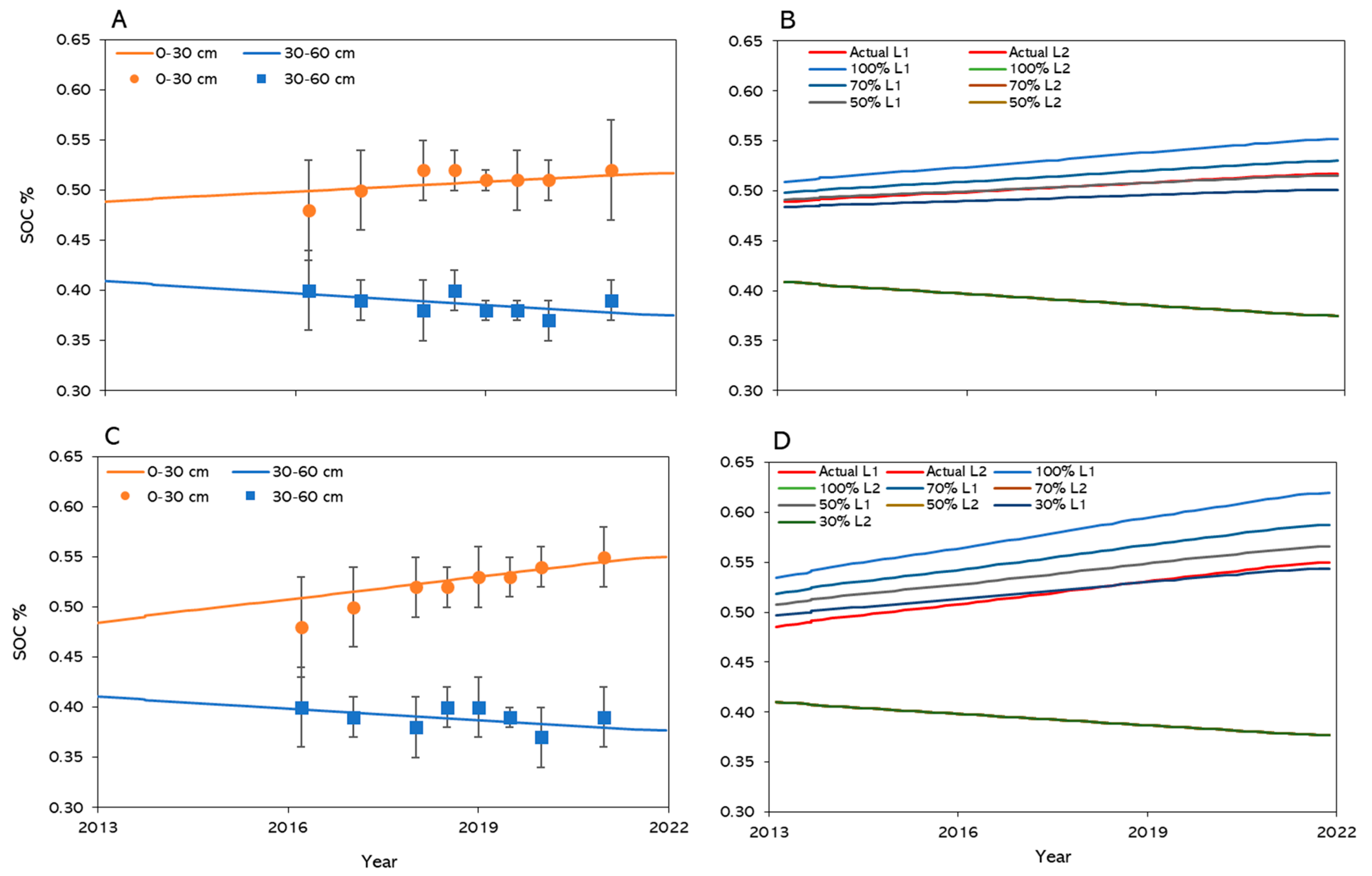

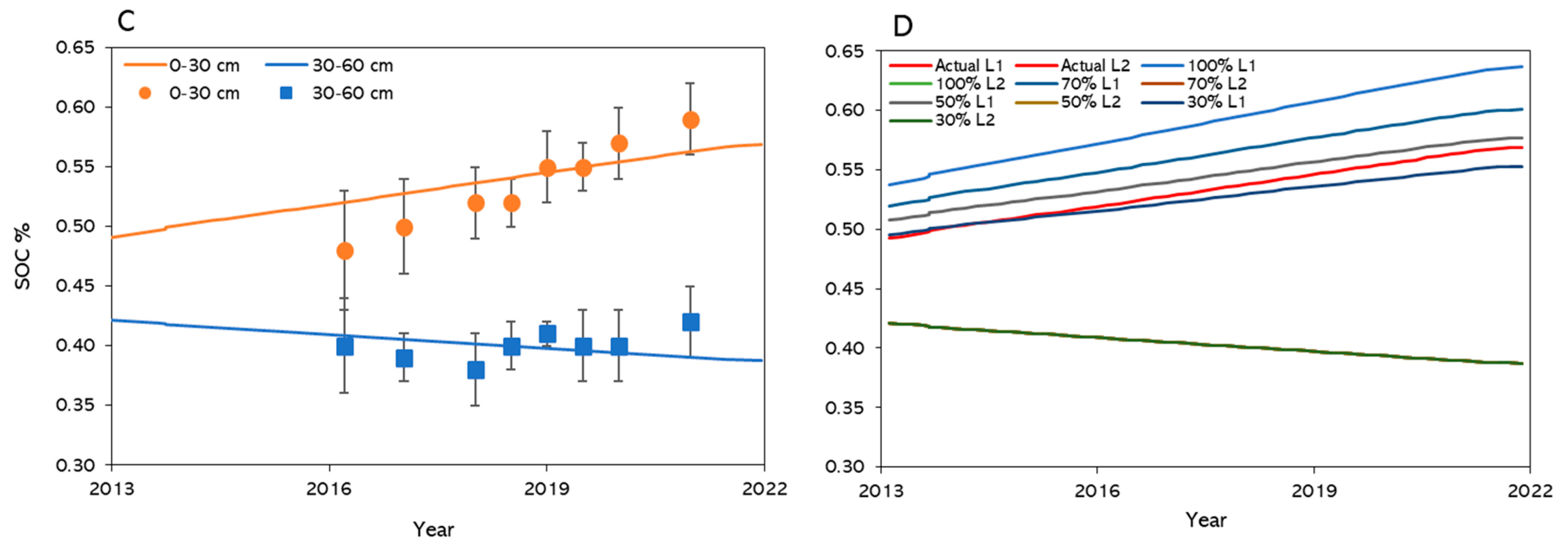
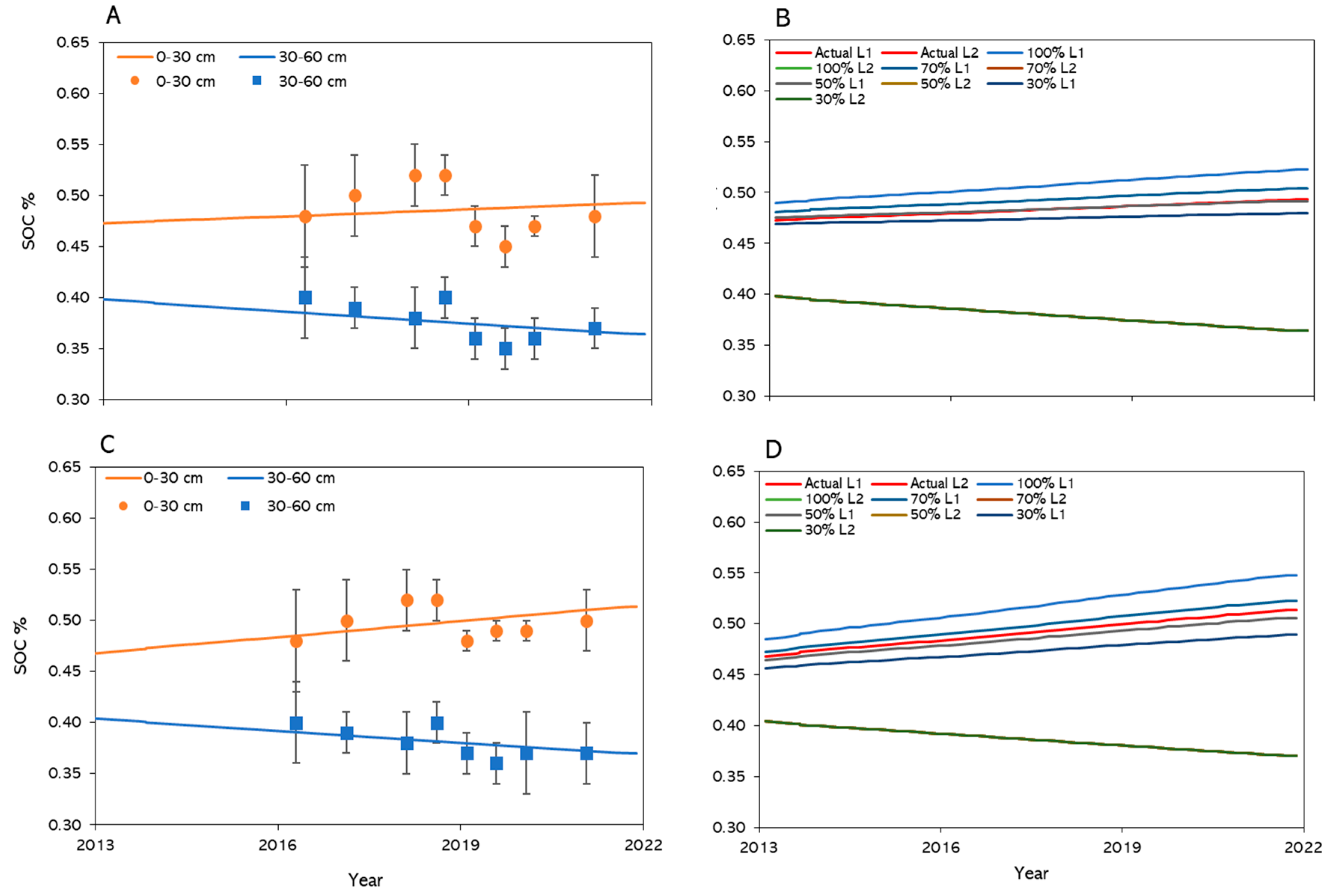

| Planting Date | Nitrogen Application Rate (kg ha−1) | Residue (kg ha−1) | Root Biomass (kg ha−1) | ||||
|---|---|---|---|---|---|---|---|
| 2018–2019 | 2019–2020 | Avg | 2018–2019 | 2019–2020 | Avg | ||
| Early | 0 | 1058.8 | 2548.1 | 1803.5 | 882.3 | 633.3 | 757.8 |
| 30 | 1377.7 | 3318.5 | 2348.1 | 1148.1 | 788.9 | 968.5 | |
| 60 | 1658.4 | 3644.4 | 2651.4 | 1382.0 | 922.2 | 1152.1 | |
| 90 | 1817.8 | 4622.2 | 3220.0 | 1514.8 | 1166.7 | 1340.7 | |
| Moderately delayed | 0 | 1128.4 | 2641.5 | 1885.0 | 940.3 | 628.4 | 784.4 |
| 30 | 1747.8 | 3859.7 | 2803.8 | 1456.5 | 918.3 | 1187.4 | |
| 60 | 1699.5 | 4379.8 | 3039.6 | 1416.2 | 1042.0 | 1229.1 | |
| 90 | 1863.9 | 4550.8 | 3207.3 | 1553.2 | 1082.7 | 1317.9 | |
| Delayed | 0 | 951.1 | 2411.4 | 1681.2 | 792.6 | 578.9 | 685.8 |
| 30 | 1337.8 | 3221.3 | 2279.5 | 1114.8 | 816.9 | 965.8 | |
| 60 | 1431.1 | 3547.9 | 2489.5 | 1192.6 | 896.5 | 1044.5 | |
| 90 | 1680.0 | 3809.2 | 2744.6 | 1400.0 | 933.6 | 1166.8 | |
| Planting Date | Nitrogen Application Rate (kg ha−1) | Depth (cm) | ∆ SOC (Mg C ha−1) | |||||
|---|---|---|---|---|---|---|---|---|
| Residue Return | ||||||||
| * Actual | 100% | 70% | 50% | 30% | ||||
| Early | 0 | 30 | 0.61 | 1.00 | 0.73 | 0.55 | 0.37 | |
| 30 | 30 | 1.12 | 1.62 | 1.28 | 1.04 | 0.81 | ||
| 60 | 30 | 1.54 | 2.07 | 1.67 | 1.40 | 1.13 | ||
| 90 | 30 | 2.05 | 2.60 | 2.15 | 1.83 | 1.52 | ||
| Moderately delayed | 0 | 30 | 0.80 | 1.22 | 0.92 | 0.71 | 0.51 | |
| 30 | 30 | 1.83 | 2.43 | 1.98 | 1.67 | 1.36 | ||
| 60 | 30 | 1.97 | 2.54 | 2.07 | 1.75 | 1.43 | ||
| 90 | 30 | 2.17 | 2.83 | 2.33 | 1.98 | 1.64 | ||
| Delayed | 0 | 30 | 0.58 | 0.94 | 0.67 | 0.49 | 0.31 | |
| 30 | 30 | 1.28 | 1.80 | 1.43 | 1.19 | 0.94 | ||
| 60 | 30 | 1.48 | 1.98 | 1.59 | 1.32 | 1.05 | ||
| 90 | 30 | 1.78 | 2.37 | 1.93 | 1.62 | 1.32 | ||
Disclaimer/Publisher’s Note: The statements, opinions and data contained in all publications are solely those of the individual author(s) and contributor(s) and not of MDPI and/or the editor(s). MDPI and/or the editor(s) disclaim responsibility for any injury to people or property resulting from any ideas, methods, instructions or products referred to in the content. |
© 2025 by the authors. Licensee MDPI, Basel, Switzerland. This article is an open access article distributed under the terms and conditions of the Creative Commons Attribution (CC BY) license (https://creativecommons.org/licenses/by/4.0/).
Share and Cite
Hussain, T.; Nualsri, C.; Ali, M.F.; Duangpan, S. Simulating Soil Carbon Under Variable Nitrogen Application, Planting, and Residue Management. Soil Syst. 2025, 9, 104. https://doi.org/10.3390/soilsystems9030104
Hussain T, Nualsri C, Ali MF, Duangpan S. Simulating Soil Carbon Under Variable Nitrogen Application, Planting, and Residue Management. Soil Systems. 2025; 9(3):104. https://doi.org/10.3390/soilsystems9030104
Chicago/Turabian StyleHussain, Tajamul, Charassri Nualsri, Muhammad Fraz Ali, and Saowapa Duangpan. 2025. "Simulating Soil Carbon Under Variable Nitrogen Application, Planting, and Residue Management" Soil Systems 9, no. 3: 104. https://doi.org/10.3390/soilsystems9030104
APA StyleHussain, T., Nualsri, C., Ali, M. F., & Duangpan, S. (2025). Simulating Soil Carbon Under Variable Nitrogen Application, Planting, and Residue Management. Soil Systems, 9(3), 104. https://doi.org/10.3390/soilsystems9030104










